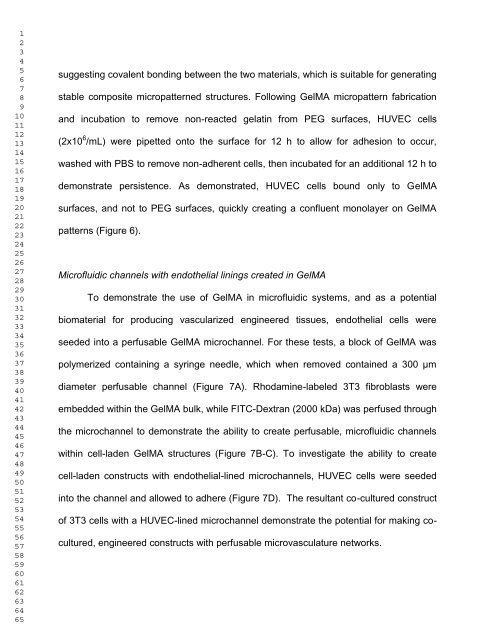Elsevier Editorial System(tm) for Biomaterials Manuscript Draft ...
Elsevier Editorial System(tm) for Biomaterials Manuscript Draft ...
Elsevier Editorial System(tm) for Biomaterials Manuscript Draft ...
Create successful ePaper yourself
Turn your PDF publications into a flip-book with our unique Google optimized e-Paper software.
1<br />
2<br />
3<br />
4<br />
5<br />
6<br />
7<br />
8<br />
9<br />
10<br />
11<br />
12<br />
13<br />
14<br />
15<br />
16<br />
17<br />
18<br />
19<br />
20<br />
21<br />
22<br />
23<br />
24<br />
25<br />
26<br />
27<br />
28<br />
29<br />
30<br />
31<br />
32<br />
33<br />
34<br />
35<br />
36<br />
37<br />
38<br />
39<br />
40<br />
41<br />
42<br />
43<br />
44<br />
45<br />
46<br />
47<br />
48<br />
49<br />
50<br />
51<br />
52<br />
53<br />
54<br />
55<br />
56<br />
57<br />
58<br />
59<br />
60<br />
61<br />
62<br />
63<br />
64<br />
65<br />
suggesting covalent bonding between the two materials, which is suitable <strong>for</strong> generating<br />
stable composite micropatterned structures. Following GelMA micropattern fabrication<br />
and incubation to remove non-reacted gelatin from PEG surfaces, HUVEC cells<br />
(2x10 6 /mL) were pipetted onto the surface <strong>for</strong> 12 h to allow <strong>for</strong> adhesion to occur,<br />
washed with PBS to remove non-adherent cells, then incubated <strong>for</strong> an additional 12 h to<br />
demonstrate persistence. As demonstrated, HUVEC cells bound only to GelMA<br />
surfaces, and not to PEG surfaces, quickly creating a confluent monolayer on GelMA<br />
patterns (Figure 6).<br />
Microfluidic channels with endothelial linings created in GelMA<br />
To demonstrate the use of GelMA in microfluidic systems, and as a potential<br />
biomaterial <strong>for</strong> producing vascularized engineered tissues, endothelial cells were<br />
seeded into a perfusable GelMA microchannel. For these tests, a block of GelMA was<br />
polymerized containing a syringe needle, which when removed contained a 300 µm<br />
diameter perfusable channel (Figure 7A). Rhodamine-labeled 3T3 fibroblasts were<br />
embedded within the GelMA bulk, while FITC-Dextran (2000 kDa) was perfused through<br />
the microchannel to demonstrate the ability to create perfusable, microfluidic channels<br />
within cell-laden GelMA structures (Figure 7B-C). To investigate the ability to create<br />
cell-laden constructs with endothelial-lined microchannels, HUVEC cells were seeded<br />
into the channel and allowed to adhere (Figure 7D). The resultant co-cultured construct<br />
of 3T3 cells with a HUVEC-lined microchannel demonstrate the potential <strong>for</strong> making co-<br />
cultured, engineered constructs with perfusable microvasculature networks.


